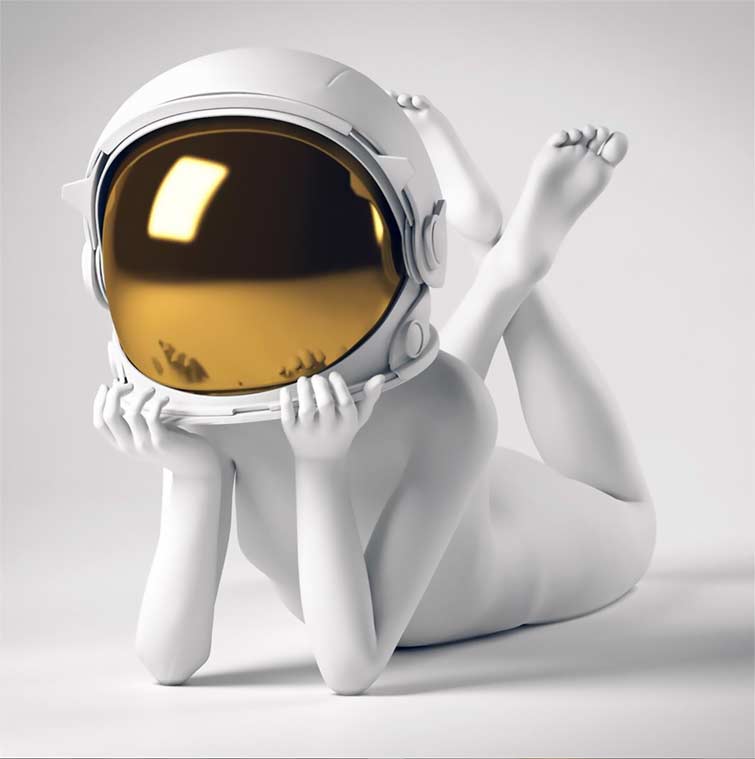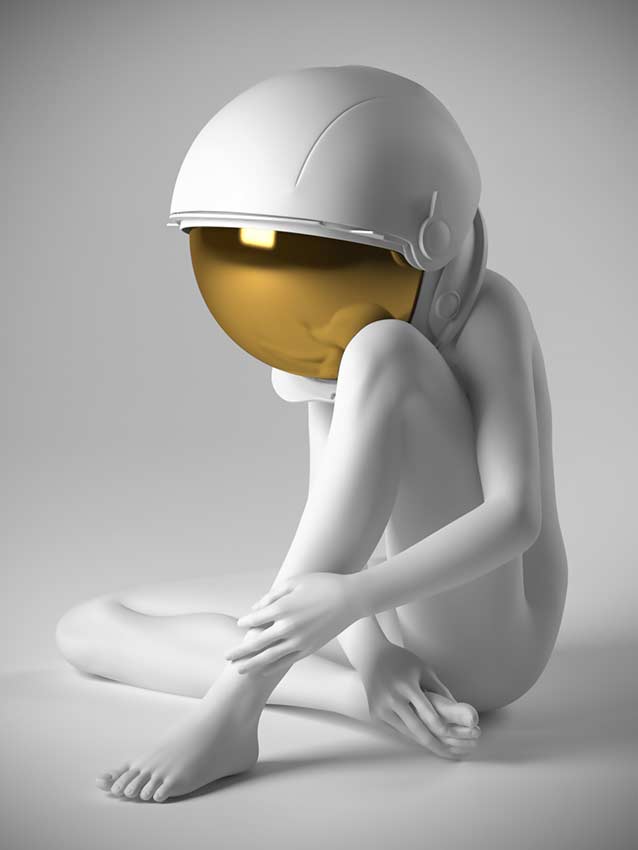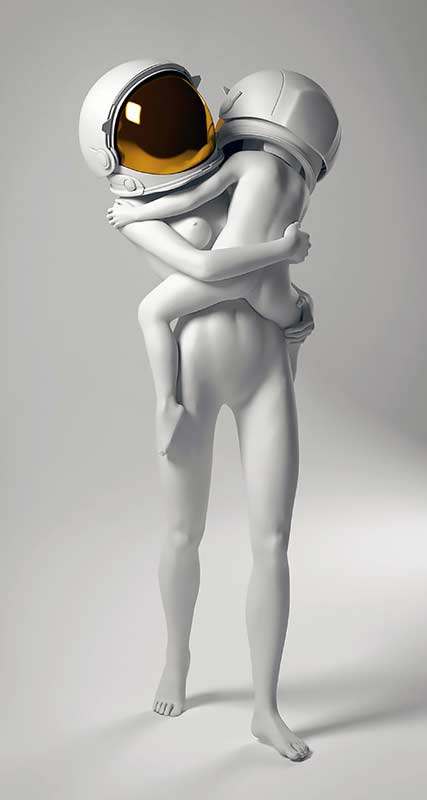An Exclusive Interview With RÉMY BOND
BY IDA SALAMON
![Remy Bond with Mendel. 2021 [Yellow Gold Leaf version completed January 2021] Carbon fiber/ Polylite 442-100 / Acrylic paint / Gold leaf 24k Height 140cm © Copyright Remy Bond, All Rights Reserved.](https://artmarketmag.com/wp-content/uploads/2021/05/VV_20201217_MENDEL_114.jpg)
It is a pleasure to interview one of the rising stars in today’s contemporary art field, a surprising artist, full of vision, with incredibly unique and sophisticated artworks!
Rémy Bond, born in 1983 in Paris, France, dreamed of becoming an astronaut. As a child, he fantasized about soaring through the black vacuum of space, traveling to distant stars, bounding across the lunar soil, and contemplating the beauty of planet Earth in complete stillness.
Today Rémy’s dream-life has grown into a massive body of creative works of art, made in a high-quality technique, featured in special exhibitions in collaboration with NASA; it takes us into the hallucinatory universe animated by paintings and sculptures of a rare beauty strike us with their essential and pure esthetic quality. The goal is to transport us to a place where time is simply suspended, and conventional modes of perception are disrupted.

Rémy’s lunar work uses contemporary codes while questioning the seemingly universal idioms of advertising and pop culture. Commonplace images and objects of our consumerist society are reconfigured in the search for a poetic meaning… Rémy appropriates and radically transforms these symbols, propelling us into a dimension of experience beyond that of our everyday routines.
![Remy Bond with Mendel. 2021 [Yellow Gold Leaf version completed January 2021] Carbon fiber/ Polylite 442-100 / Acrylic paint / Gold leaf 24k Height 140cm © Copyright Remy Bond, All Rights Reserved.](https://artmarketmag.com/wp-content/uploads/2021/05/VV_20201217_MENDEL_344.jpg)
Remy’s artworks shuttle us into a new lunar universe. At the project’s core is a series of gigantic portraits of pop culture icons, which appear dressed in NASA space suits, surrounded by cosmic landscapes, whether imaginary or monochromatic. Through these lysergic displacements of imagery, Rémy pays discreet homage to these giants of the public imagination while at the same time questioning their status and influence in
our society. Through his Art and creativity, Rémy encourages us to fulfill our own childhood dreams by inviting us into a sort of surreal embassy of the imaginary lunar world on a trajectory envisioned by the poet Charles Baudelaire,
“Beyond the sun, beyond the ethers, beyond the confines of the starry spheres.”

Art Market Magazine: Thank you, Remy, for this fascinating interview. Before we start talking about your special exhibition at the Kennedy Space Center in April 2018, and your latest outstanding project of sculptures, let’s first talk about your background in Art.
How did it all begin? Did you study Art, and did you come from an artistic family?
Remy Bond: Thank you for having me; it’s a pleasure having this interview. I grew up in Paris, I had the chance to be surrounded by Art all my life.
Being a Parisian is like living in a museum, surrounded by architecture, sculptures, and history in every corner street.
I have always been very sensitive and curious, trying to understand the meaning of Art and being continuously connected by spending all my summers at the Tuileries garden, using Paris as a playground. As a child, I remember running after the ducks around the fountain or playing around the Louvres’ sculptures in regular everyday life. I was surrounded by arts all the time and became so aware and connected.
I saw these gigantic paintings and sculptures made by masters like Leonardo da Vinci, Eugène Delacroix, Michelangelo, Antonio Canova, or Rodin… and I definitely grew as an artist with this passion for discovery, mostly for putting my emotions through creativity. Inspired by this connection with the Renaissance’s greatness.
I discovered Art’s power, the motion of space and time behind the paintings and sculptures that I was so fascinated about. The Renaissance was and still is the most incredible Art period; those artists’ genius is timeless. I studied arts in Paris, I was definitely a free spirit student! Looking back, I think that the only thing I really took from the fine art school and that I really use every day is to use the right tools.
I remember one of my art teachers continually telling me all day and every time he saw me working at the studio, “Remy, use the right tool! the right brush! be professional!“. this never leaves me. Today, my creativity uses the right tools, the best materials I can find; I’m working with the best Maitre d’art in the world.
But if we go deeper to the background, to my childhood, My father was a chef and a photographer in his free time;
I always saw him with photo and video equipment, high-quality gear that I was playing with. My mother is a seamstress, So I believe my artistic DNA comes from both of them.

A.M.: Your main focus in the painting’s series is gigantic portraits of pop culture icons, celebrities who appear dressed in NASA spacesuits, surrounded by cosmic, imaginary, or monochromatic landscapes. Tell us where this inspiration and muse came from?
R. B.: My Art has this notion of Spacetime, which connects the passing and the future. I like the idea of taking the past and bring it into the future. This is something core in my Art. I like to use Art as the bond, this link of connection, between a dream and reality, between the past and the future. It’s definitely something emotional and absolutely not in a materialist way. I don’t believe sculptures or paintings are really important; this is what is behind… the will, the soul of the artist, the transcendental emotions that we can get from. And of course, the information about the period gives us the ability to understand the bigger picture and the more profound life stories.
A.M.: In 2018, you had a solo exhibition in collaboration with NASA at the Kennedy Space Center, Florida. A beautiful show where you featured a series of paintings. How did this collaboration with NASA start?
R. B.: At first, NASA contacted me for an exhibition at the California Science Center Museum; this was a fantastic show. Followed by a spectacular exhibition at the Kennedy Space Center. I’m artistically involved in space foundations with Buzz Aldrin, and we are actually working on some future exhibitions. It’s a beautiful journey and the experience to share my arts in the Space Field/world. The exploration of space is significant in humanity’s history; I believe that Art and Space exploration has the same core. Behind masterpieces like the Mona Lisa and a Rocket launch, there are so many years of work, engineering, genius, preciseness, and this is definitely not something effortless!
But “we do these things not because they are easy but because they are hard,” as President Kennedy said in 1962,
to become humanly great.
A.M.: In Florida, you exhibited paintings of Mickey Mouse and David Bowie; what is connecting you with both of them?
R. B.: I’m using Art as a tool to tell a spacetime story by using contemporary codes; I grew up watching Mickey and listening to David Bowie, and I believe Art must have this bond between emotion and spirit. I sincerely believe that Art has the power to elevate individuals, to penetrate them. I have this will, do not just be part of a present dialogue but to transcend time. We are at a time when people are watching the stars again; we can see this renewed interest and fascination of the general public and in movies.

A.M.: Do you consider yourself a Neo-pop Artist?
R. B.: Yes. I definitely had the will to be in this Pop dialogue with Warhol, David Hockney, Jeff Koons…
I love this generous and contemporary way of sharing emotions.
A.M.: What is your relation to kitsch and commercialism?
R. B.: I believe in quality art, and this is something you can feel when you see great Art. Beyond the will of the artist, the pieces themselves attract the viewers and also receive their energy. The will behind the object can transcend the material and become relevant, even more, when the Art is abstract as Mendel is.
It reminds me of Jeff Koons’ retrospective at Center Pompidou, beyond the sculptures’ abstract like his balloon dog. I remember this feeling of experiencing a great piece of Art and well-made sculptures and paintings that we can call “kitsch and commercial.”
But Koons definitely mastered in giving with full of emotion, to abstract objects by making them beyond reality and using the best specialty to provide forms to his emotions. And I think the freedom of Warhol is spectacular! Expressing his feelings by playing with commercialism as he did intend to find meaning through them.
A.M.: Your last series of sculptures are awe-inspiring. The sculptures are carried out in a very clean and contemporary style, large scale white figures (mostly women) with a golden helmet. On the one hand, the artworks create a very distant feeling for the spectator and yet, on the other hand, make a very soft- touch and elevate curiosity.
What is the main idea behind this series of work?
R. B.: They are definitely influenced by the Renaissance, by using the body as a tool of emotion. Every detail, every expression hides a deep soul, an invitation… a will to connect and share to the world. Through each work of Art, there’s a desire to open a dialogue, a will to find a way to share what can’t be said, can’t be understood.
Sculpture has this power of connecting where words are limited for expressing emotion, a feeling, something really profound. I like the idea of private dialogue; I don’t have the will to reach as many people as possible. But I feel the need to connect with individuals who will recognize themselves through my Art in a shared emotional dialectic.
In my Art, you can see my worldview, my emotions, my dreams. I believe Art is the door of emotion, a vehicle of bonding, and this emotional experience is something unique to each of us, the result of our personal life experiences.

A.M.: The sculpture “Bonding” features a woman and child, and I was impressed by its height of 180 cm. Can you tell us more about its background?
R. B.: Nothing is stronger than the bond of a mother to her child. This is an unconditional bond, something that goes beyond emotions, rationality, or even love. The mother gives memory cells that the child will go through all his life. And beyond this fusional bond, we have to deal with this notion of “connection and disconnections.” This connection is needed to develop our immune defenses, so we feel protected, and the disconnection is for us to become independent.
It is part of all life cycles to be connected and disconnected. It is elementary in all development processes;
It is at the heart of creation, of learning; it is a universal law of mother nature.
Unfortunately, with the passing of a beloved one, when he disconnects from this world, his being’s real depth will crystallize to us; this disconnection gives us a real glimpse of his personality, life, and greatness.
Bonding also reminds me of Ad Patriam, a beautiful sculpture by Charles Jacquot that I loved going to see at the Petit Palais.

A.M.: The latest sculpture depicting two persons holding each other’s hands was named “Tsuzamen” (2020). From where does the word derive from, and what did you want to express with this work of Art?
R. B.: “Tsuzamen” means “Together” in Yiddish; this sculpture is a metaphor whos definitely make sense more than ever in 2021, be and work together in the same direction, and move forward for a better future.
“Tsuzamen” is one of my most difficult projects to achieve due to the density of the subject of Holocaust survivors. By finding the right way of the duty to remember while keeping my artistic freedom.
I wanted to use these two girls as an allegory representing all survivors from Auschwitz… everything has been thought and made with this purity and innocence of the body, an idealistic point of view trying to transcend all physical layers to get through the emotions, the soul of the sculptures. This project will be released with a voice-over video by the end of 2021.

